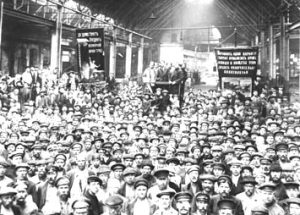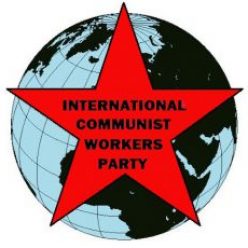Educators, Youth, Industrial Workers Rethink The Path To Revolution here ♦ Industrial Workers’ Key Role in the Russian Revolution and Civil War here ♦

New elections to the Petrograd soviet at the Putilov factory, 1917. The left banner reads: “Long live the Party of the universal Army of Labor.” The right banner reads: “To create a locomotive means to bring close to the end hunger and misery, as well as to give a final blow to capitalism.”
Educators, Youth, Industrial Workers Rethink The Path To Revolution
SEATTLE and PORTLAND (USA), March 3— Friends and comrades have responded well to the ICWP call to rejuvenate communist political struggle among industrial workers. The more we talked about communist revolution, the more our friends became interested in helping to expand industrial collectives.
Boeing workers and young activists are helping to update a pamphlet about a massive rebellion of Boeing workers in 1995. In what came to be known as Rolling Thunder, ICWP comrades organized unprecedented marches through the plants chanting “Shrontz (CEO) got the gold, and we got the shaft!” Black women led these marches and then joined communist collectives.
Industrial workers and soldiers have revolted often. They played key roles in the Russian Revolution, using the weapons they built to advance the revolution. ICWP comrades have organized several labor insurgencies. Writing about the strengths and weaknesses of these rebellions will help convince new comrades to join the struggle in the factories.
Building Communist Relationships With Workers
At a Portland (Oregon) collective meeting, Peter, an anti-racist educator, described a professor he’s known for many years. This professor is disconnected from the working class, so his ideas come solely from what he reads. He hopes for a revolution. Yet he’s told Peter that industrial workers cannot be a leading force for revolution.
Peter sent him a recent Red Flag article about how crucial communist relationships with young industrial workers are to building for revolution. The professor loved the article.
Students and educators can learn from gatherings, forums, and picket lines organized by industrial workers. Relationships can develop and class consciousness will grow.
Only revolutionary communism will end the racism against, and exploitation of, students and workers. In communism, the wall between academic learning and vocational training will crumble. Whenever possible, educators should start to demolish this obstacle to class consciousness.
Teachers, Students Consider Communist Organizing
Comrade Jane reported on conversations with three people who are seriously considering joining ICWP. Two are teachers.
These teachers are used to steering their working-class students away from industry and the military. After discussing the revolutionary role of industrial workers, they saw the need to re-think their position. There can be no revolution without expanding communist collectives in the factories and among soldiers.
Another new friend, Olivia, a student activist, also said that this approach was new to her.
The discussion led her to ask questions about how communism will function, and how revolution would happen. She asked how Party members answer when people say, “Communism didn’t work.” They discussed how it was socialism that failed, not communism. Our party has confidence that workers are smart and can adopt communist ideas and run with them once they understand them.
Olivia liked it when Jane asked her to question everything, including the comrade. She asked, “What do you say when people say communism was invented by white people?’
Jane talked about communist leaders and thinkers who were not white. She plans to talk more about the masses in Africa, Latin America, and Asia who have fought for what they hoped was going to be communism. About the party’s growth today worldwide.
These discussions help our friends think about how they can help mobilize young people to play key roles in communist revolution. After these discussions, Olivia distributed ICWP literature to her friends.
Beware Of Enemies Bearing Gifts
A retired boilermaker now helps design training programs for vocational high schools. He warned us that the ruling class is not spending billion$ on industrial training out of the goodness of their heart.
The US military has fallen behind their imperialist competitors, especially China. A draft of the new National Defense Industrial Strategy says, “The problem stems from insufficient production and insufficient supply chains.”
Foreign Affairs clarifies: “Stockpiling weapons is impossible given the dearth of skilled American labor.”
As proxy wars and the threat of world war expand, building communist collectives in industrial settings takes on a new urgency. Building these industrial collectives and relationships is key to revolutionary work.
Industrial Workers’ Key Role in the Russian Revolution and Civil War
The Putilov Works was the biggest industrial factory in Petrograd (now St. Petersburg) at the time of the 1917 Russian socialist revolution. Workers from this plant had helped start the revolution of 1905 and February 1917. That revolution overthrew the Tsarist regime and began the buildup to the Russian Revolution in October 1917.
The Putilov plant had manufactured most of the tsarist regime’s weapons. When the revolution started, the workers took the weapons they made to the front lines. They taught Red soldiers how to use them. They fought side by side with them on the front line.
The core of the Bolshevik Red Army came from these factories. The outlook and commitment of the Putilov workers spread to other industrial workers.
Their support buoyed the Bolshevik Party. By late October 1917, the Bolsheviks successfully led the revolution to overthrow capitalism.
Putilov workers proved their revolutionary loyalty by joining the workers’ militia, the Red Guard. This was organized and led by the Bolshevik-led Military Revolutionary Committee.
An observer told of meeting militia soldiers who identified themselves as being “from the Putilov works.” He described the dedication and power of these factory workers turned militia. “The streets were full of armed detachments of Red Guards from the factories, marching in the direction of the new front” to counter the forces of the revisionist Kerensky.
The workers at the Putilov Works published a resolution signaling their support for the Military Revolutionary Committee. The establishment of this military committee essentially handed military control of Petrograd to the Bolsheviks. It can be seen as the first step of the Bolsheviks’ seizure of power.
This is an example of how industrial workers, especially those in arms factories before and during a world war, were a key force for revolution. Along with soldiers and sailors, they will be a key force today.

